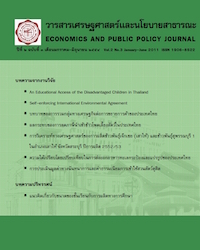Self-enforcing International Environmental Agreement
Main Article Content
บทคัดย่อ
This paper aims to analyze the stability of self-enforcing International Environmental Agreement (IEA). In this paper the stability of an IEA is studied using a twostage game. In the first stage each country decides non-cooperatively whether or not to join the IEA, and in the second stage signatories and non-signatories make decision on the levels of their emissions. This study has employed two conjectures for analyzing signatoriesF and non-signatoriesF emissions in the second stage. The first conjecture is based on Cournot assumptions, where signatories and non-signatories simultaneously choose their emissions. The second conjecture is based on the Stackelberg assumptions, where signatories are the first players to choose their emissions. The analytical results have shown that non-signatoriesF emissions are lower than signatoriesF emissions in both Stackelberg and Cournot cases. Moreover, this study has employed the numerical simulation to explain how the stability conditions operate to select a stable IEA. The results show that the number of signatories in both Stackelberg and Cournot cases are determined by the slope of marginal damage cost. The number of signatories in the case of Stackelberg is always higher than that in the case of Cournot, whereas total pollution in the case of Stackelberg is lower. However, the weakness of Stackelberg case is that the number of countries that sign in the IEA decreases when the slope of marginal damage cost increases. Since signatoryFs net benefit is lower whereas non-signatoryFs net benefit is higher when the slope of marginal damage cost rises, non-signatory that looks like a free rider gains from the increase in the slope of marginal damage cost whereas signatory who is the first player to choose her emission loses her net benefit. Thus, the number of signatories decreases when the slope of marginal damage cost rises.
Article Details
ประเภทบทความ
บทความวิจัย
สงวนลิขสิทธิ์ © 2553 คณะเศรษฐศาสตร์ มหาวิทยาลัยศรีนครินทรวิโรฒ
คณะเศรษฐศาสตร์ มหาวิทยาลัยศรีนครินทรวิโรฒ จัดพิมพ์วารสารเศรษฐศาสตร์และนโยบายสาธารณะ เพื่อเผยแพร่บทความวิชาการทางเศรษฐศาสตร์ นโยบายสารธารณะ และสาขาอื่นๆที่เกี่ยวข้อง ทัศนะและข้อคิดเห็นใดๆ ที่ปรากฏในวารสารเป็นความคิดเห็นส่วนตัวของผู้เขียน โดยบทความที่ได้รับการตอบรับจะถือเป็นลิขสิทธิ์ของคณะเศรษฐศาสตร์ มหาวิทยาลัยศรีนครินทรวิโรฒ
บรรณาธิการ อาจารย์ ดร.พลพัธน์ โคตรจรัส


